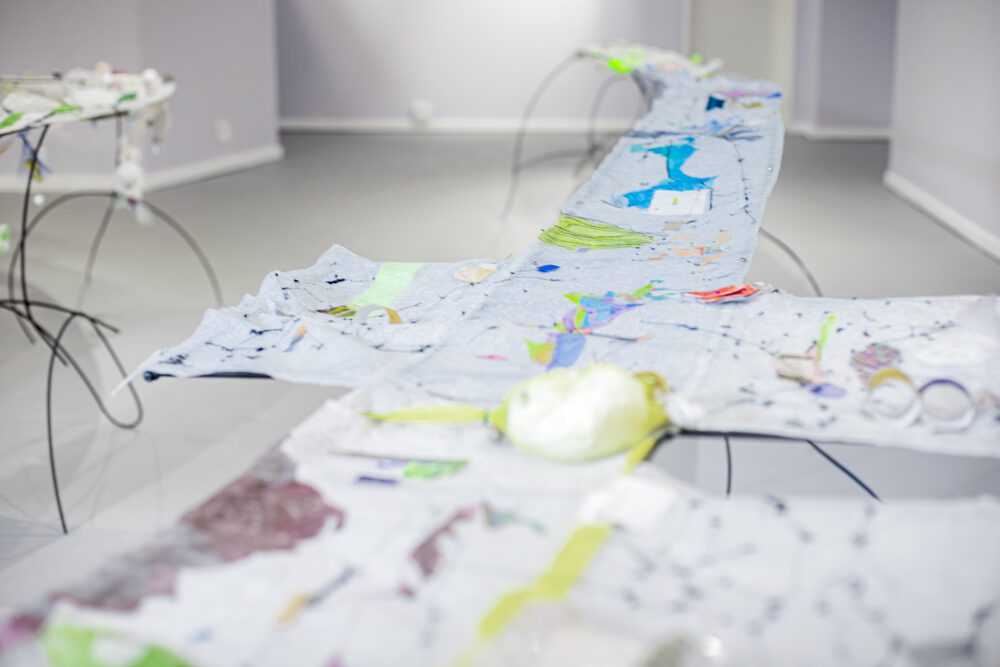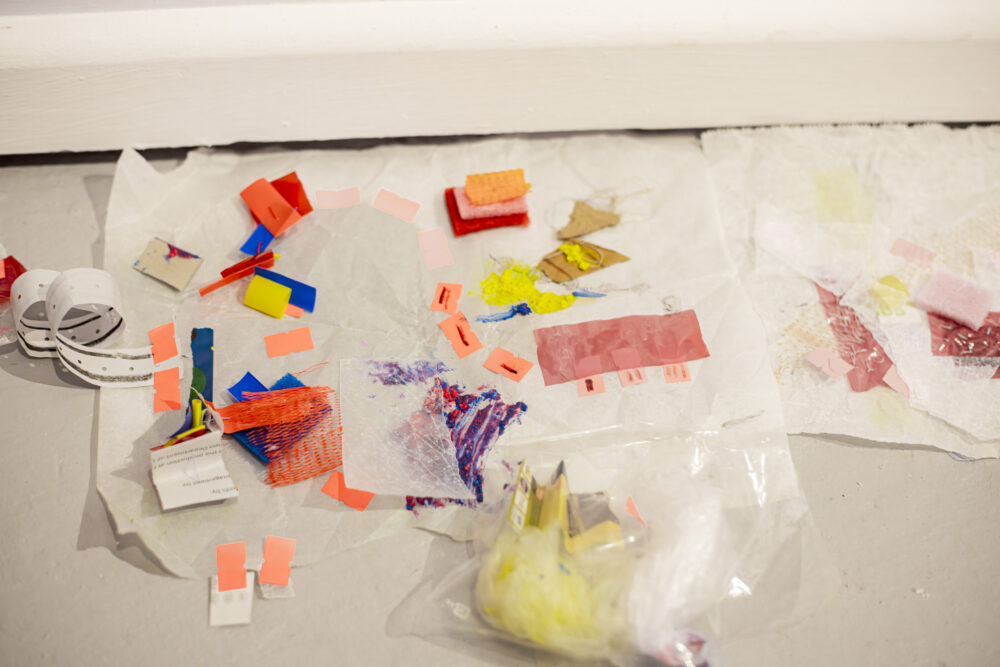Nyakallo Maleke
makes joy an
art form
A few days after returning from a rain-soaked National Arts Festival in Makhanda, I sat down for a reflective conversation with multidisciplinary artist Nyakallo Maleke — whose quietly magnetic exhibition To Teach in Ways That Teach Us to Take Care of the Soul left an impression on me.
The show, in its title and form, invites viewers not only to look but to participate, to make, to reflect and to feel.
Our phone conversation was a gentle unravelling of process, philosophy and personal memory. Maleke, who had just returned from Makhanda herself, was recovering from the whirlwind that often comes with installing and presenting a major body of work: “I was exhausted,” she laughed, “and I’m still recovering.” Yet, her voice was clear, grounded and generously open.
“The title comes from a book by American writer bell hooks,” Maleke tells me as we begin our conversation about her exhibition. It’s a long, lyrical title, one that lingers and, like much of Maleke’s work, it’s not interested in shortcuts or summaries. It asks for your attention, your patience and your willingness to feel.
The book she references explores alternative approaches to education. It offers a way of learning that emerges not through rigid systems but through life, through vulnerability, through care and experience.
“Hooks draws from thinkers like Paulo Freire,” Maleke continues, “who wrote about education for the oppressed. I’m drawn to both of them because I want to contribute to new modes of learning, ones that centre lived experience.”
This emphasis on the soul, on feeling, remembering and making isn’t just conceptual in Maleke’s practice. It is embedded in the materials she uses: baking paper, cardboard, thread, wax, that carry a sense of home, of slowness and process.
They don’t shout. They don’t demand. They invite.
In this particular body of work, Maleke describes returning to the beginning of her drawing practice.
“I wanted to revisit how this conversation between materials and memory started. So much of what I used, like the cardboard and the thread, has been with me for a long time. Some of it comes from the market. Some of it reminds me of things I saw my mother doing.”
What results is not just an exhibition but a process: “The way I stitch, for example, is very intuitive. I don’t design beforehand. I go with the flow,” she says. “It becomes a conversation with the materials.”

 All stitched up: A work (left) from Nyakallo Maleke’s installation To Teach in Ways That Teach Us to Take Care of the Soul, which was recently on at the National Arts Festival in Makhanda, and a scene from the show’s interactive room, where exhibition-goers could co-create (right).
All stitched up: A work (left) from Nyakallo Maleke’s installation To Teach in Ways That Teach Us to Take Care of the Soul, which was recently on at the National Arts Festival in Makhanda, and a scene from the show’s interactive room, where exhibition-goers could co-create (right).
This dialogue between artist and medium, between memory and form is what gives the work its textured, layered energy. It doesn’t attempt to arrive at a single message. Instead, it allows space for wandering, for pausing, for unknowing.
A moment that perfectly captured this openness occurred during a walkabout of the exhibition. As I stood in the gallery space, someone suddenly pointed out a shongololo, a curled-up centipede resting on one of the artworks. At first, we thought it might have been intentional.
It looked so at home there, as though it had been stitched into the piece. We soon realised it had probably fallen through a hole in the gallery roof, landing perfectly in place. The moment was strangely poetic, a reminder that even nature responds to the invitation in Maleke’s work.
When I shared this with her, she was moved. “That’s so beautiful,” she said. “Nature definitely plays a role in my design decisions. A lot of the shapes I use are drawn from organic movement, like curves and spirals.
“I want the structures to feel effortless, like they grew into place.”
Indeed, those physical structures that hold the large stitched drawings emerge from collaborative processes with other makers.
There were no preliminary sketches. “I worked with Daniel, a collaborator I’ve worked with before. We used instructions and prompts, rather than plans. The legs of the structures, for example, came from something he had already been exploring. The process was intuitive and shared.”
The drawings themselves are monumental in scale, two 20-metre pieces joined seamlessly, but they were built slowly, piece by piece.
“The whole drawing took about two months,” Maleke said. “And it was made with the help of an assistant. It was laborious, but meaningful. Every part of it was built from the centre outward.”
Despite their scale, the works never feel overwhelming. They hold a softness, a kind of invitation to lean in. That same spirit extended into one of the most beloved parts of the show: an interactive room where visitors were invited to make things with the same materials Maleke uses.
“I wanted to offer people a sense of what it feels like to be in my studio,” she said. “There’s often a gap between the artist and the viewer — this wall of misunderstanding or miscommunication. The interactive space was a way of dissolving that. I wanted people to feel free to play, to contribute, to be part of the conversation.”
The result was deeply human. People stitched, folded, marked. In a world that often demands perfection or performance, Maleke had created a space where everyone could simply make.
“I’m interested in how people can have their own ‘each one, teach one’ moments,” she explained. “I’m not having this conversation alone. The work is about shared learning. Shared imagination.”
This emphasis on learning, particularly learning that’s embodied and intuitive, runs throughout her practice.
“I treat drawing as a kind of writing. It’s how I process space. It’s how I navigate memory. It’s how I deal with public environments and personal history. Even when I’m not drawing something recognisable, I’m still writing with materials.”
And sometimes, when language fails, the materials speak: “There are times when I can’t find the right words,” she reflected, “and in those moments, I let the materials communicate for me. It’s a very tactile, very emotional conversation.”
There’s vulnerability in that but also a deep sense of care. Her drawings are not illustrations. They are meditations. And central to them is the idea of community, of holding and being held.
It’s that kind of intentionality that resonates with Standard Bank, long-time supporters of the arts and the festival. Maleke is one of this year’s Standard Bank Young Artists for visual arts — a title that carries not just prestige but deep structural support.
As Yolisa Koza, head of brand experience, puts it: “When we look back at the 180-plus artists who’ve received the Standard Bank Young Artist Award, many are now internationally recognised. That in itself is a massive indicator of success.
“Supporting artists like Nyakallo at this pivotal stage in their careers isn’t just about sponsorship — it’s about shaping a future where the arts remain central to how we tell our stories and imagine our world.”
As our conversation drew to a close, I asked Maleke what she hopes people take away from experiencing this work — especially as it prepares to travel to Joburg.
“I hope it offers a sense of joy. Even if just for a moment. I hope it allows people to feel free to experience something nourishing for the soul. Because that’s what the process was for me — it was joyful, fulfilling, meditative.”
With a gentle laugh, she added, “And my name means joy. So, I try to carry that into everything I do.”
When so much art is consumed fast, documented for social media and discarded just as fast, To Teach in Ways That Teach Us to Take Care of the Soul reminds us to slow down. To make. To feel. To remember.
As Maleke continues to evolve her practice, what remains constant is her commitment to drawing, not just as mark-making, but as meaning-making. Her work reminds us that care is a creative act and joy, too, can be revolutionary.